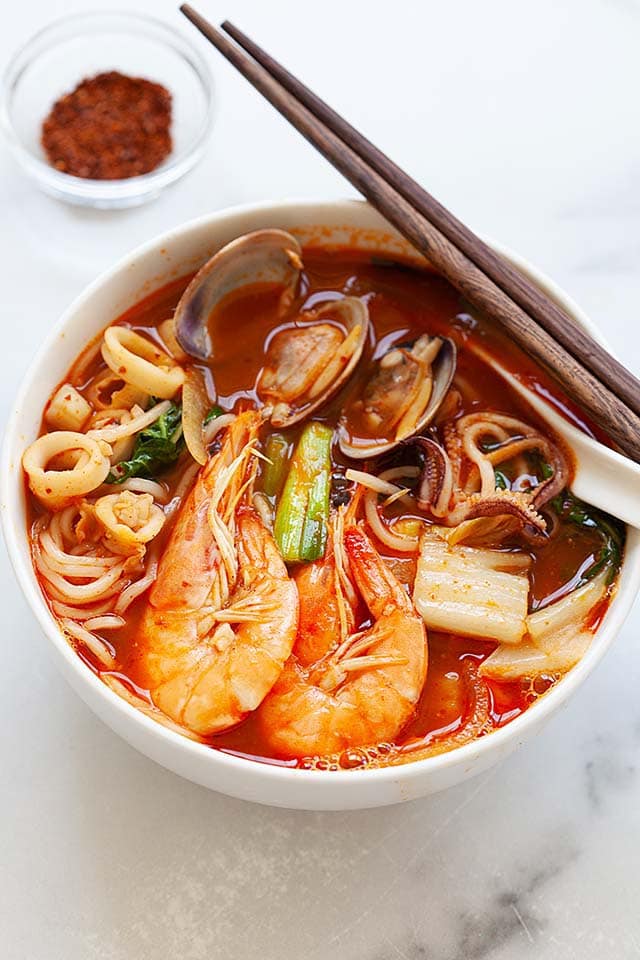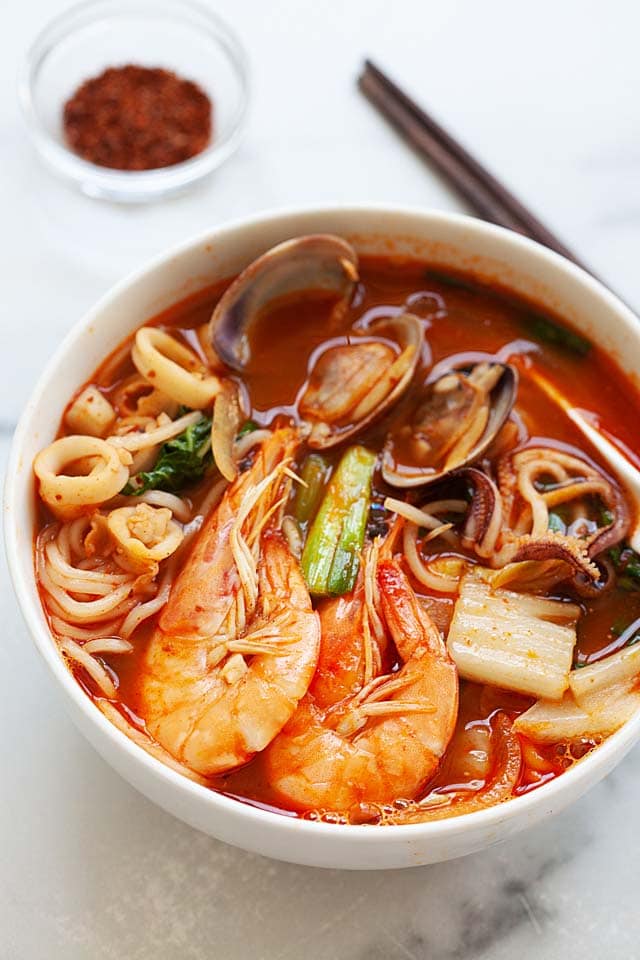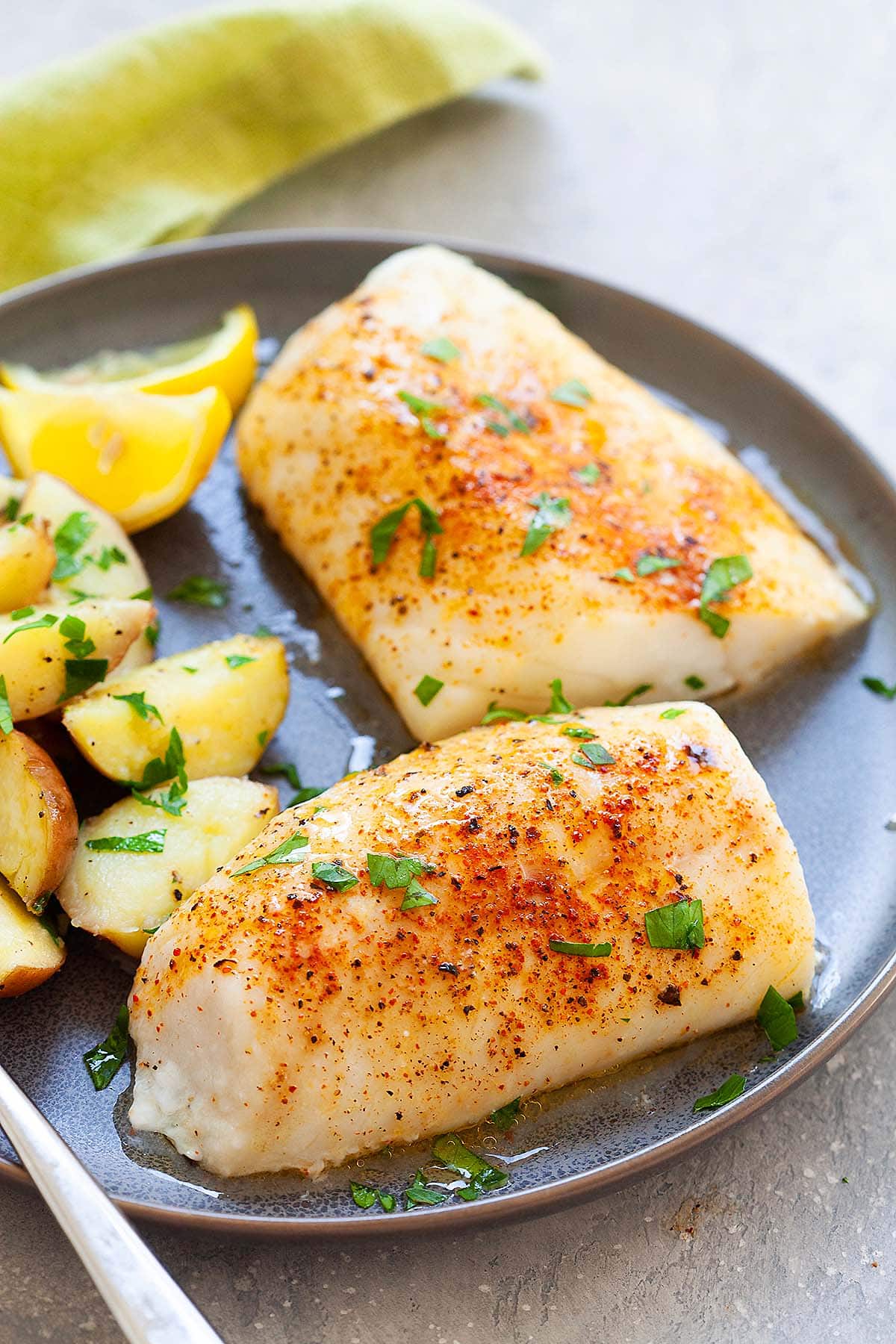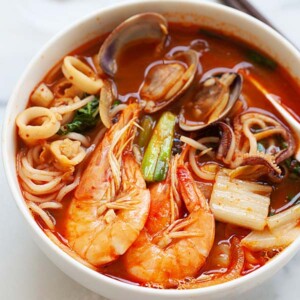This post may contain affiliate links. Please read my privacy policy.
Jjamppong is a spicy Korean seafood noodle soup. This Korean-Chinese recipe is delicious and so easy to make at home. Try my Jjamppong recipe, it's authentic and tastes better than Korean restaurants.

Jjamppong
Jjamppong is a spicy Korean noodle soup with seafood in a spicy broth. It’s a Korean-Chinese dish with its origin in China.
Called 炒码面 (chaomamian) in Chinese, this dish originated from Hunan and traditionally made with a white color bone broth.
The Chinese restaurants in Korea started to adapt the dish to Korean flavors by adding Korean chili powder (Gochugaru) and chili paste to the noodle soup, making the soup red and spicy.
Jjamppong is one of the iconic Korean-Chinese dishes and well loved by many. It’s my personal favorite and I often order them at Korean-Chinese restaurants, or I would order the original Chinese 炒码面 at Sichuan or Hunan restaurants.
For more spicy soup recipes, check out my hot and sour soup.
Looking for more delicious Korean recipes? Check out my Spicy Korean Chicken next!

Ingredients For Korean Seafood Noodle Soup

My recipe calls for a variety of vegetables and seafood. Jjamppong is made of the following main ingredients:
- Fresh wheat noodles. You can get fresh noodles from Asian or Korean stores.
- Napa cabbage.
- Bok choy.
- Shrimp.
- Manila clams.
- Squid.
- Bay scallops.
Please refer to the recipe card at the bottom of this post for full details on each ingredient.
How To Make Jjamppong

Step 1. Cook the fresh noodles according to the package instructions until al dente, or until there is a firm bite in the center. Drain and set aside. Do not cook them all the way through.

Step 2. On high heat, heat a pot with the cooking oil. Add the garlic and onion, and stir-fry until aromatic. Then, add the shrimp, clams, squid, scallops, gochujang, and chili powder. Stir to combine well.

Step 3. Add the broth, followed by the napa cabbage and bok choy. Bring the soup to a quick boil. Add soy sauce and salt to taste. Add the noodles to the soup and cook for 30 seconds, then stir in the scallions. Turn off the heat and serve immediately.
What Kind Of Noodles To Use

There are many types of noodles in Asian markets and it can be overwhelming and confusing if you can’t read the language or not familiar.
For Korean Jjamppong noodles and many other noodle recipes, you will need fresh wheat noodles, such as the picture below.

These noodles are usually labeled as Korean Fresh Noodles, or Fresh Noodles. If you can’t find Korean brands, you can certainly get similar fresh noodles in Chinese markets. They are very similar, except the thickness of the noodles.
Cooking Tips

- DO NOT overcook the fresh noodles. Follow the package instructions and cook until al dente (with a bite and not cooked through), drain and set aside. The noodles will continue to cook after you add them into the spicy soup.
- Do not overcook the seafood. Start by adding the shrimp, then follow by Manila clams, squid and bay scallops.
Frequently Asked Questions
This recipe is only 435 calories per serving.

What To Serve With This Recipe
Serve this spicy seafood noodle soup with other Korean recipes. For a healthy meal and easy weeknight dinner, I recommend the following recipes.
I hope you enjoy this post as much as I do. If you try my recipe, please leave a comment and consider giving it a 5-star rating. For more easy and delicious recipes, explore my Recipe Index, and stay updated by subscribing to my newsletter and following me on Facebook, Pinterest, and Instagram for new updates.
Other Recipes You Might Like


Jjamppong (Korean Seafood Noodle Soup)
Ingredients
- 8 oz. (230g) Korean fresh noodles
- 2 tablespoons cooking oil
- 3 cloves garlic, minced
- 1/2 small onion, peeled and cut into pieces
- 8 oz. (230g) medium-sized shrimp , (10-12)
- 12 oz. (350g) Manila clams
- 4 oz. (125g) squid, cut into rings
- 4 oz. (125g) bay scallops , or sea scallops
- 4 tablespoons gochujang, Korean Chili Paste
- 1 tablespoon gochugaru, Korean chili powder
- 4 cups chicken broth, or bone broth
- 4 oz. (125g) napa cabbage, cut into pieces
- 4 oz. (125g) bok choy
- 1-2 tablespoons soy sauce, or to taste
- salt , to taste
- 2 stalks scallions, cut into strips
Instructions
- Cook the fresh noodles according to the package instructions until al dente, or until there is a firm bite in the center. Drain and set aside. Do not cook them all the way through.
- On high heat, heat a pot with the cooking oil. Add the garlic and onion, and stir-fry until aromatic. Then, add the shrimp, clams, squid, scallops, gochujang, and chili powder. Stir to combine well.
- Add the broth, followed by the napa cabbage and bok choy. Bring the soup to a quick boil. Add soy sauce and salt to taste. Add the noodles to the soup and cook for 30 seconds, then stir in the scallions. Turn off the heat and serve immediately.
Notes
Nutrition
Nutrition information is automatically calculated, so should only be used as an approximation.










I went to a Korean grocery store and bought a bag of stock bags that I boiled instead using the chicken stock. I boiled them according to the package and followed this recipe from there. The stock bags made the recipe more authentic and it was amazing. Thanks
Awesome! :)
Can you substitute rice noodles for this recipe? I am allergic to gluten
Yes you can.
Korean Chinese food is still Chinese food. Just like American Chinese food is til Chinese food. And pizza is still Italian despite it practically being an American staple.
not all Chinese food is the same nor is pizza actually Italian ( it is american Italian nor is it an American staple. Korean food is actually different just like Guamanian food is not Japanese, what do you think Vietnamese food, Cambodian food Laotian food is, it’s food based on the culture of that country as well as the ingredients available in that country or that region of that country.
Agreed.
Actually, pizza IS Italian (born in the Campania region), it was just wasn’t a national food like it is in America. https://www.history.com/news/a-slice-of-history-pizza-through-the-ages#:~:text=Pizza%20has%20a%20long%20history,to%20the%20city%20of%20Naples.
I retract my statement about it not being Italian but if you look at it pizza here in the U.S. is not a true Italian pizza this article is from Salvatore’s Italian pizza Bringing It Back
Long before pizza, as we know it today, gained the respect it deserves, it was considered a peasant meal or ‘poor food’, according to the wealthy Italian locals of Naples. In the 1880’s, you could spot pizza being sold by street vendors and in small, unpopular restaurants as a simple yet custom menu choice. It simply wasn’t the go-to meal of choice and was often looked down upon. And then the King and Queen paid a royal visit to Italy in 1889. Bored and unamused with their normal French feasts, the two decided to send away for a variety of pizzas made locally. And they were pleasantly satisfied. So satisfied that the famous ‘Margherita pizza’ was named after Queen Margherita herself. Pizza became known as a whole new cuisine and gained its extraordinary popularity quite quickly. Over the years and across the globe, pizza has been transformed to suit the styles of others.
Traditional Italian Pizza
A Whole Pie
Unlike what American culture has taught us about pizza, Italian pizza is served as a whole pie. You will order a pizza by the whole, sit with your family, and share pieces of each style. Each Italian family offers their own twist to the whole pie pizza. But you won’t be getting a single slice.
The Main Ingredient
…Is the sauce! You can forget the canned tomatoes or sauce from a store. With real italian pizza, you will find homemade sauce made from freshly peeled tomatoes and a blend of savory, complimenting herbs. You will also notice that authentic Italian pizza doesn’t combine the toppings and sauce to be cooked together. They simply layer the sauce along the crust. You may even notice some pizzas without sauce and just a drizzle of olive oil. This is called ‘bianca’.
Top it Off
You may be surprised to find that small discs of thinly sliced pepperoni aren’t on the menu at an authentic Italian pizzeria. Instead, a generous portion of prosciutto, large chunks of mozzarella, a variety of hand-picked herbs and greens such as rosemary, basil, arugula, and capers. Eggplant, garlic, and green peppers are also popular Italian choices for pizza toppings. Traditionally, Italian pizzas are hearty, flavorful, and savory. Thereby American pizza is just a cheap but delicious knock off
What can you use in place of the fresh noodles?
Packaged dry ramen noodles.
Can I use frozen bag of seafood?
Yes you can.
Can I use udon noodles instead?